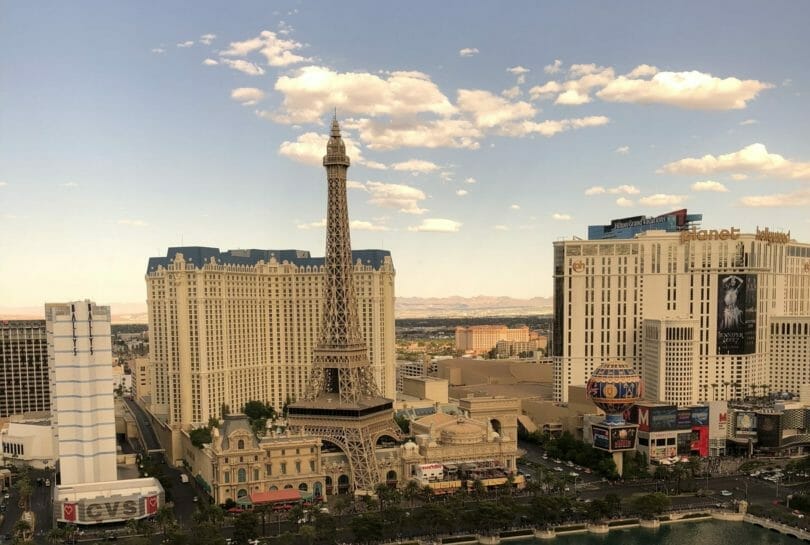Some links in this article include affiliate links, which provide a commission if a purchase is made. Affiliate links have no impact on our recommendations.
Las Vegas is a big metropolitan area, and while some aspects of it may be easy to get around, some aren’t, or aren’t as obvious. The strip itself is miles long, and then when you factor in other aspects like getting to/from the airport or downtime, the choices proliferate.
In today’s post I wanted to talk about some key ways, both free and paid, to get around. Some are easier than others; some are more cost effective than others; and some are more accessible than others. But all can provide support to various portions of the visitors headed to Las Vegas, and I hope you’ll find this value.
Now, I’m sure this title doesn’t necessarily inspire tons of confidence for some of you reading it, but I’m starting off being honest – despite a number of visits over the years, I continue to learn about new ways to get around.
So while I’ve included a very lengthy list below, I’m sure someone will at some point will comment about an option that’s been added, or I simply didn’t know about. (And please do! I’ll update the article periodically.)
Walking
Let’s start with the obvious. Getting from one Fremont Street casino to another, or strip casinos within a certain proximity, can absolutely be navigable.
More adventurous types can walk a good portion of the strip; I’ve made my way from Luxor to Wynn and back in a day before, and I’ve survived, although I was crazy sore the next day.
Of course, if walking was fine, you probably wouldn’t be reading this article. But if walking is OK as part of your transportation, the next section is a good supplement to take some of the effort out.
Free Monorails
There are three free monorails connecting properties on the Las Vegas strip. All three connect properties that are or were connected to MGM/Mlife.
Mirage-Treasure Island Tram
A monorail connects Mirage and Treasure Island. It was out of service for a considerable amount of time a couple of years ago, but is back up and running. AS of this posting, the hours are somewhat more restricted, and the monorail won’t run during bad weather or maintenance windows.
The monorail runs every five minutes or so, so it’s not a lengthy wait.
Aria Express Tram
The Aria Express connects Park MGM (albeit after a long hallway walk that brings you practically to the door of Aria) to the Crystals shopping center (near the Aria hotel lobby entrance) and then through to Bellagio (again through a somewhat lengthy hallway).
It can certainly cutdown on the walking time if you’re going from Park MGM to Bellagio. And with two trains, you don’t have to wait more than a handful of minutes or so for one to arrive.
Excalibur-Mandalay Bay Tram
The final free tram runs between Excalibur and Mandalay Bay. If you’re leaving from Excalibur, you can take a direct shot to Mandalay Bay. From Mandalay Bay, you stop first at Luxor, and then at Excalibur. The ride is just a few minutes in either direction.
With all three of these rides, they’re all on one side of the strip. For the other side, there’s another (albeit paid) option.
Other Mass Transportation
Beyond the three free monorails, there’s two more traditional mass transit options in Las Vegas to help get around.
Paid Monorail: Las Vegas Monorail
The Las Vegas Monorail started as a free train connecting MGM Grand and Bally’s. It was then extended to stop at other locations, which include most of the Caesars-owned properties, and then beyond to other casinos such as Westgate and Sahara.
A one-way ticket is $5 and a ride all day pass is $13; multi-day passes are available, and you can sometimes get deals or discounts over at vegas.com for tickets.
Some monorail stops are more convenient than others; I’ve gotten lost coming back in from MGM Grand more than once, and the walk from the Bally’s casino floor to the monorail feels nearly interminable, while the stop at Harrah’s, for instance, is incredibly convenient.
But given how far up and down the road it can take you, it can be a great saver on your feet.
Bus Network
There are multiple bus options that run up and down Las Vegas Boulevard, as well as to the airport, Fremont Street and other parts of the metro Las Vegas area.
The Deuce is the core route that runs up and down the main strip area but also reaches downtown Las Vegas and the Fremont Street area. It runs 24 hours a day, and comes through every 10-15 minutes.
For areas closer to downtown there’s The Loop, which runs between the Strat, the outlets and the core Fremont Street casinos area.
Bus passes for the bus network can be bought as a single fare, 24 hour pass or a 3-day pass on the app. Single fares are actually more expensive than the monorail, but the single day and three day passes are a better deal than the monorail’s single day and multi-day fares.
Vehicle-Based Transportation
Beyond mass-transit opportunities, there’s a number of car-based options to get around.
Rental Cars
As I write this, rental cars are in short supply and expensive. But they are available, and for people who need to get around a lot, may be more cost effective than paying for a lot of other ways to get around, or losing time awaiting that next mass transit arrival. Book early, and monitor prices as they are fluctuating quite a bit right now.
Taxis
Taxis have been a common form of transport in Las Vegas for years. A big change in the last couple of years has been flat rate pricing between the strip casinos and the airport; there are three zones, ranging between $19 and $27, with a flat rate to get either to and from the airport.
Outside of that, metered rates apply, and I’ve tended to find them relatively reasonable, at least compared to what I’m used to in other markets like New York City.
Ride Share
Like in other cities, ride share apps have popped up, with Uber and Lyft being the predominant choices, but prices have been higher during busier times and a pronounced driver shortage has been consistently reported to be an issue. Whether you’ll spend more on a taxi or ride share will depend on the day and time, and both fare-driven services may be hard to get a vehicle during peak times.
Limousines
It’s Vegas, so we can’t forget about this one – there are also limousine services that can provider a higher scale (or higher capacity) arrangement for people going to and from various local destinations. Pricing will usually depend on the number of people being transported, the length of time needed and the distance being traveled, not unlike other services.
Shuttles
Finally, for those looking for specific/common routes, there are shuttle services that will do things like airport drop-off and pick-up scenarios to hotels. Like many services during the pandemic, shuttle options have largely been dormant, but are expected to return at some point.
How do you get around Las Vegas? Is there an option you rely on that we’ve missed? Share in the comments!








